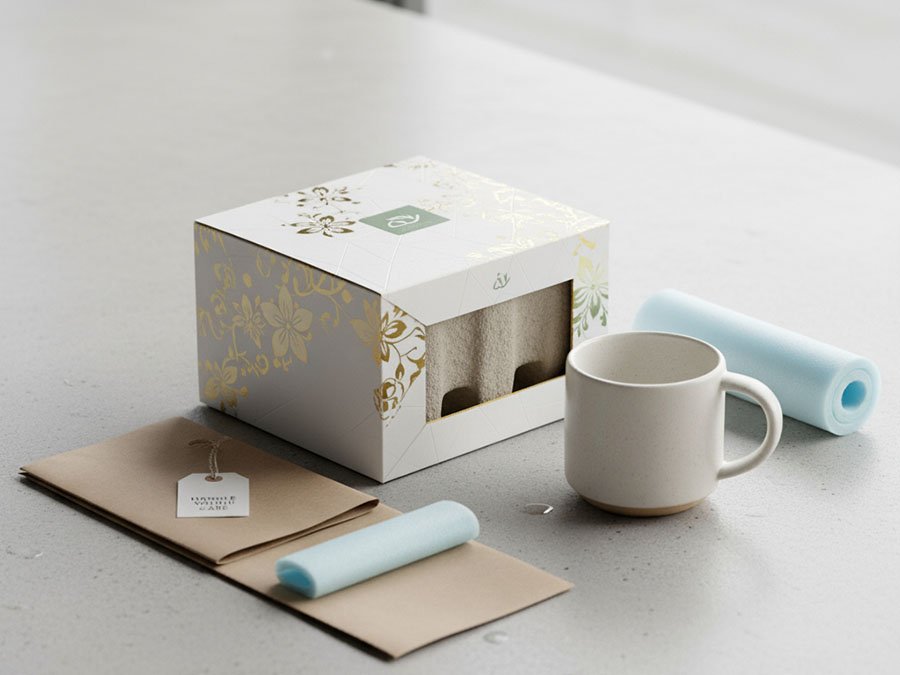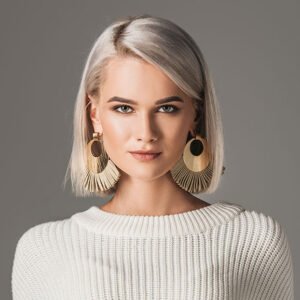
When you buy a cute mug (maybe for yourself or for your mom), do you actually care about the box? But here’s the thing: for the people selling that mug, the packaging is kind of a big deal. It’s like the hype man nobody notices. The right box? It can totally shape how people see the mug, keep it from breaking on the way to your kitchen, and sometimes it’s even cooler than the mug inside. Wild, right? Brands know this. That’s why they fuss over those custom boxes like they’re wrapping the crown jewels.
This blog will dive into all things mug boxes: what works, what fails, and how to choose or design the ideal shipping boxes, coffee mug boxes, or mug packaging to delight customers and keep mugs safe.
Why Packaging for Mugs Is a Special Challenge
Mugs are inherently fragile. Ceramic, porcelain, or glass means that even small shocks—drops, pressure, vibration—can crack or shatter them. Because of that:
- You need buffer zones inside the box (padding, dividers, foam, etc.).
- The outer shell must be rigid and strong enough to survive handling.
- Your packaging also needs to be compact (so you don’t waste space or pay huge shipping fees) yet protective.
A clever packaging design strikes the balance between protection, cost, and branding.
What the Research Says About Packaging Influence
Packaging isn’t just functional — it actively influences how people perceive the product. For example:
- Studies of food and snack packagingfind that design features (color, texture, labeling) can significantly affect purchase decisions.
- In the realm of coffee and drinkware, Researchshows these elements can actually influence how customers perceive flavor, acidity, or strength. Basically, smart design isn’t just about aesthetics—it directly shapes how products are experienced and, ultimately, how well they sell.
- A packaging-optimization algorithm used by e-commerce companiesshowed that by better matching package type to product attributes (including fragility), damage rates dropped by 24% while cost was managed.
All that is to say: your mug packaging choice is both protective and psychological.
Types of Mug Boxes & Packaging Options
Here are common styles and elements you’ll see (or want) when designing or choosing mug packaging or coffee mug boxes:
| Packaging Type / Feature | Purpose / Use Case | Pros | Trade-offs / Challenges |
|---|---|---|---|
| Corrugated shipping boxes (single wall, double wall) | For sending mugs to customers via mail or courier | Good strength; affordable; widely available | If too thin, may get crushed; must size well |
| Die-cut insert boxes or tuck-flap boxes | For retail display or gift packaging | Clean look; easy to open; can integrate brand art | Usually needs foam or liner inside for protection |
| Dividers / inserts (cardboard, foam, molded pulp) | To separate mugs and prevent collisions | Prevents damage, especially when multiple mugs | Adds cost, weight, and sometimes complexity |
| Foam or molded inserts / cutouts | High-end presentation and protection | Premium feel; snug fit | More expensive; longer lead times |
| Surface treatments (lamination, spot UV, embossing, coatings) | Aesthetic finishing touches | Makes custom mug boxes “pop” and feel premium | Added cost; sometimes conflicts with recyclability |
| Water-resistant coatings or anti-static liners | For mug shipping boxes exposed to varied climates | Protects against moisture, humidity, static | Must ensure coatings are safe and durable; cost adds up |
In many real use cases, packaging is hybrid: a rigid shipping box with protective foam inside and a decorative custom mug box insert or sleeve.
Designing Your Own Custom Mug Boxes
If you’re considering going custom, here are some best practices and tips:
1. Start with measurements and tolerances
Don’t just eyeball the mug’s size. Measure height, width, handle protrusion, and carves (if irregular). Then leave a margin—typically 3–5 mm or more on all sides—for padding materials.
2. Incorporate internal supports
- Use die-cut cardboard insertsthat hold the mug in place.
- Use foam or molded pulpcutouts that hug the shape.
- Use corrugated cardboard dividersif you’re shipping sets of mugs (2, 4, 6, etc.).
As a rule of thumb, the mug should not shift inside the box more than a few millimeters.
3. Select durable outer materials
Choose a strong corrugated stock (single or double wall). Reinforce corners or edges if stacking is possible. Some custom packaging options also use water-resistant or anti-static liners to handle humidity fluctuations.
4. Think about print, branding, and finishes
Your custom mug boxes are also a branding opportunity. You can:
- Print your logo, tagline, artwork, or even a “story of the mug / maker”
- Use finishes like matte, gloss, spot UV, embossing, or foil accents
- Incorporate seasonal themes (e.g. holidays, limited editions) — also known as seasonal packaging, which can drive extra sales.
Just remember, heavy decorations should not compromise recyclability or over-increase cost.
5. Order samples & test rigorously
Before committing to large print runs, always test:
- Drop tests
- Compression / stacking tests
- Vibration or shipping simulation
- Real-world shipping routes (local, overseas)
Testing can catch weak points before you lose product to breakage.
How to Pack & Ship Mugs Safely
Even with a perfect custom box, packing technique matters. The best boxes won’t help if the item shifts inside. Here’s a step-by-step:
1.Clean and dry the mug
Any moisture or residue inside can damage decorations or cause slipping.
2.Wrap the mug
Use multiple layers: first tissue paper or kraft, then bubble wrap or foam. Secure with tape (but avoid sticking tape to the mug surface).
3.Optional: inner box or sleeve
For extra safety, place the wrapped mug in a small inner box, then into the outer mug packaging / shipping box.
4.Line the bottom of the shipping box
With padding (foam sheet, shredded paper, foam peanuts)
5.Place the mug centrally & fill voids
All around, top, bottom, and sides. The mug should be immobilized.
6.Use dividers / inserts if shipping multiples
Prevent mugs from bumping against each other.
7.Seal box we
Use strong tape across all seams, corners, and edges.
8.Label “FRAGILE / HANDLE WITH CARE”
And mark “This Side Up” if relevant.
9.Test before shipping for real
Shake the box gently — nothing should move.
If you ship mugs often, consider documenting your premium packaging method and maybe filming it for customers to show how seriously you take their order.
A helpful how-to resource: How to Package Mugs for Shipping
Also, a community forum tip:
Lorem ipsum dolor sit amet, consectetur adipiscing elit. Ut elit tellus, luctus nec ullamcorper mattis, pulvinar dapibus leo.
“Wrap in bubble wrap, put in a small box. Place a small box in a larger box with padding all around.”
Comparing Real-World Cases: Standard vs. Custom Boxes
Let’s consider a hypothetical example: You sell a 12 oz ceramic coffee mug.
| Scenario | Packaging | Cost Estimate (per unit) | Protection | Branding Impact |
|---|---|---|---|---|
| Basic corrugated box + bubble wrap | Bulk generic box, wrap, shipping container | $0.80 | Moderate (if packed well) | None or minimal |
| Branded sleeve over generic box | Wrap, then insert a printed sleeve | $1.20 | Moderate to good | You get brand visibility |
| Fully custom mug box with inserts + outer shipping box | Two-layer design, molded insert, printed art | $2.00–$3.50 | Very high | Strong brand impression |
Depending on your margin and sales volume, investing in custom mug boxes might be fully worth it — especially when it can reduce breakage and increase perceived value.
Interesting Fact: Packaging Influences Perceived Flavor
It is mentioned earlier that the look and feel of packages affect perception. One particularly funny but revealing observation: in coffee branding, customers sometimes report that coffee “tastes stronger” or “sweeter” depending on cup color or branding cues, even if the brew is the same.
So yes, a mug presented in a polished, well-designed coffee mug box may help you sell not just a vessel, but an experience.
Final Thoughts & Action Steps
To wrap up, your mug boxes, coffee mug boxes, custom mug boxes, and shipping boxes are far from “just boxes.” They’re part of your brand’s voice and the first physical impression a customer gets. When done right, they protect your product and help sell your brand story.
If you’re ready to improve your mug packaging, here’s a quick action checklist:
- Measure your mugs carefully and allow for padding.
- Choose a rugged outer shell — corrugated board, reinforced edges.
- Decide on inserts: foam, molded pulp, or cardboard dividers.
- Design visuals, branding, and finishes (lamination, embossing, etc.).
- Order prototypes, test them in real shipping.
- Iterate: adjust dimensions, padding, or materials until breakage is negligible.


